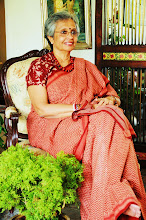Indira Nagar resident Sabita Radhakrishna has founded an organisation that gets volunteers to spend quality time with senior citizens.
 Their children have flown the nest. They have to take care of themselves. Needless to say, they feel lonely.
Their children have flown the nest. They have to take care of themselves. Needless to say, they feel lonely.
Sabita Radhakrishna has founded a voluntary organisation, Udhavi, for such seniors.
“These days, aged parents either prefer to live by themselves or need someone to take care of them, even if they live with their children,” says Sabita.
Udhavi sends its volunteers to seniors to provide them companionship or to render some help. They spend quality time with the aged, taking them out for walks or any events, chat with them, read books to them, play indoor games with them, write letters or run errands for them.
For seniors to make use of the services of Udhavi, they have to register with the organisation and also produce a consent letter from their children.
“We train our volunteers to be patient and be prepared to repeat any chore the seniors tell. They are instructed to keep from giving any medical advice, prying into the personal affairs of the aged, discussing financial matters and giving any unsolicited advice. The volunteers are not supposed to give any food or refreshments,” she adds.
“Udhavi is still a fledgling organisation and we seek advice and help from Dignity Foundation whenever required,” says Sabita.
“As a child, I was attached to both my paternal and maternal grandparents. I grew up with them. So, I always have a special concern for the aged ,” she explains the reason behind her work.
Sabita Radhakrishna is supported by a group of like-minded friends who have personal experience in the care of the aged. They form Udhavi’s core committee.
Among this group are Jayashree and Sanjay Dattatri. They are the proprietors of Old is Gold, a store selling a range of products that help in the care of the elderly. Kanchan Jayaram, an entrepreneur, is another member. She takes care of her aged parents and mother-in-law.
“This is not assisted living. Udhavi is not about rendering any specialised or professional care.
It is all about companionship, cheering them up, trying to be positive and spending some time with them,” they say. Radhika Krishnamohan, another active member, says, “The quality most required in the care of senior citizens is patience. Whenever I find the time, I spend some time with the aged in my neighbourhood.” Udhavi is a mother’s tribute to her daughter. Sabita Radhakrishna lost her daughter Deepika in 2001. “My daughter had always wanted to help those in need. It took these many years for me to do something that she would have loved to do,” says Sabita.





